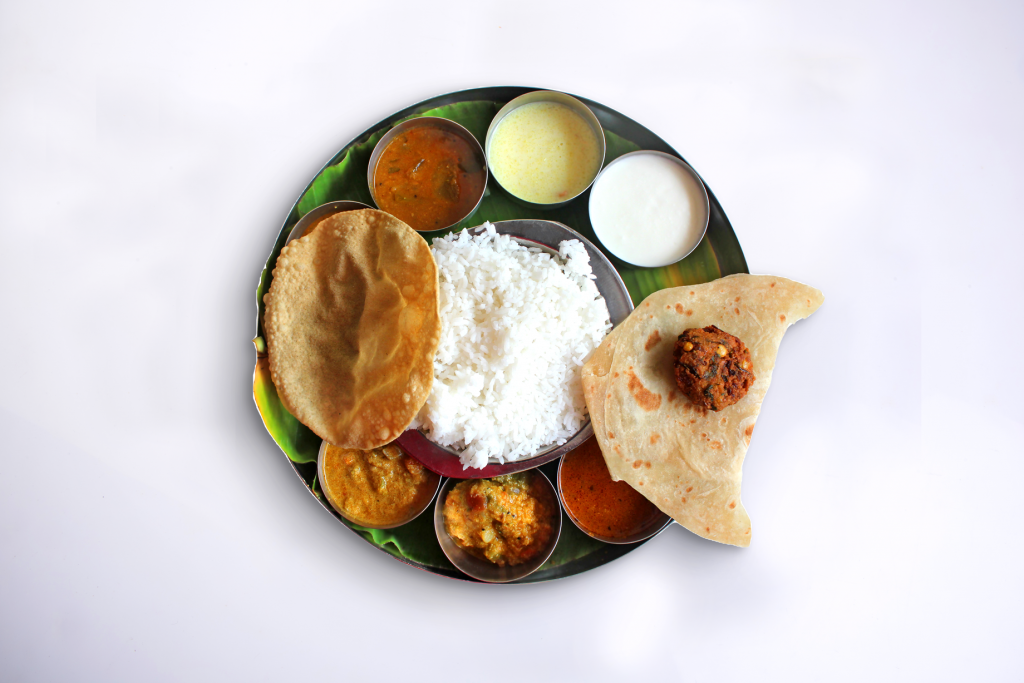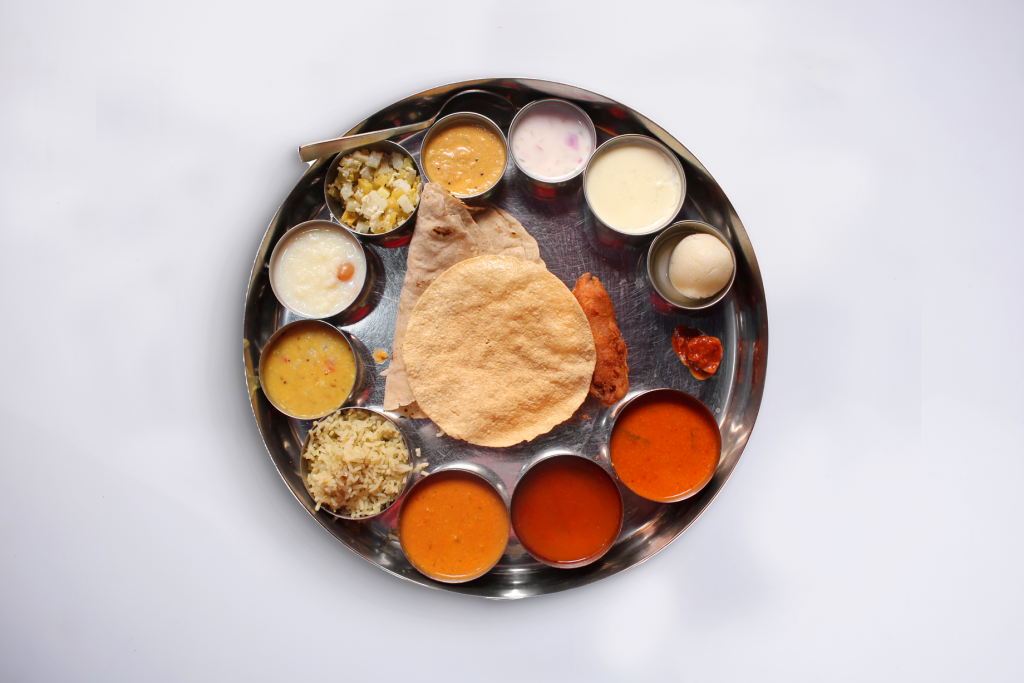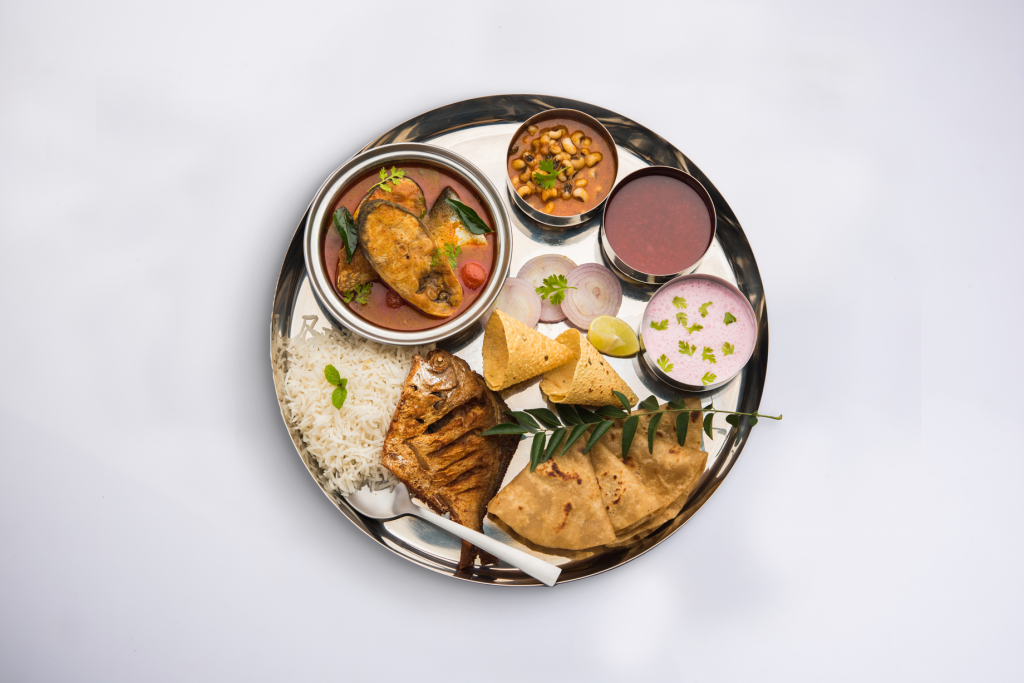India is home to extraordinary over-the-top delicious and flavorful food that will transport you to food heaven. When eating Indian food, you are guaranteed to experience a plethora of flavors in just one sitting. What characterizes India is its undying love for food items, as its cuisine is not only different in taste but also the ingredients used and cooking methods.
In addition, what makes Indian cuisine vastly unique from other cuisines is also its dining etiquettes and how the food is served. For instance, sitting on the floor and eating is a common practice in India. Eating with your hands is part of Indian culture. Most Indians prefer eating with their fingers rather than using cutlery. You will find people eating in a thali in every corner of India.
In an Indian traditional thali, there are no courses as all of the food is served together on one platter. It has now become the most popular method for serving meals in India.
What is a Thali?
Thali is a Hindi term for a large plate. It’s a stainless steel platter with small katoris or bowls, each containing a separate dish. Thali’s usually have 4 to 6 steel bowls. The purpose of a thali is to create a balanced and nutritional meal-offering 6 different flavors: sweet, salt, bitter, sour, astringent, and spicy on a single plate. The servings have proper proportions. Thali is an integral part of everyday eating, festivals, and celebrations like weddings.
Types of Indian Thali:
Every region in India has their version of thali as it varies from region to region. Thalis are both vegetarian and nonvegetarian. All thalis include condiments like chutney, pickle, and raita. Below is a list of common types of thalis found around India.
1. North Indian Thali

Known as the spiciest, colorful and flavorful thali. North Indian thali is heavily influenced by Punjab and its surrounding areas. In this thali, you will find the usage of rich and hearty Moghul elements like milk, cheese, yogurt, cream, nuts, saffron, chilies, and ghee (clarified butter).
Some of the items that a North Indian thali include are Punjabi chole (chickpea curry), palak paneer (spinach with cottage cheese), paneer tikka (grilled paneer with veggies), dal makhni (creamy lentils), butter chicken (chicken with spiced tomato and butter sauce), khadi chawal (rice with chickpea flour yogurt curry), saag (leafy vegetable), paratha (flatbread), ladoo and gulab jamon. To gulp down the meal, sweet lassi is served at the end. North Indian thali is the most prevalent around the globe with its ingredients readily available in major supermarkets.
2. South Indian Thali

What makes South Indian thali unique is its served over a banana leaf. The curries, lentils, pappadum, and condiments are placed around the side of the leaf with a large serving of rice in the middle.
The thali is primarily vegetarian with main components including rice, lentils, vegetables, and fruits like coconut with heavy use of spices like cinnamon, cardamom, and nutmeg. Some of the main entrees include rasam (spicy soup), sambar (lentil based vegetable stew), idli (rice cakes), sabzi (vegetable curry), and medu urad dal vada (fritters).
3. Gujarati Thali

As the climate in Gujarat is dry, it is common to add jaggery to food to stay hydrated. A Gujarati thali includes flatbreads: rotili, thepla, and puris. Some farsans or snacks you will spot on the thali are samosas (fried potato pastries), dhokla, and chakri (gram flour snack). Main entrees include dal (lentils), shaaki (vegetable curry), kadhi (chickpea flour yogurt curry), khichdi (rice with lentils). Some delicious desserts include doodhpak (rice pudding) and jalebi (Indian-style funnel cake).
Additionally, Gujarati thali also has certain seasonal items. Aamraas (mango pulp) is served during the summer and undhiyu is served in the winter.
4. Bengali Thali

Bengali cuisine uses a unique blend of spices called paach phoran. This is a mixture made of five whole seed spices: mustard seeds, nigella seeds, fennel seeds, fenugreek seeds, and cumin seeds. This spice blend is used in most Bengali dishes. Thali is a mix of vegetarian and nonvegetarian dishes.
Fish and rice are a staple in Bengali cuisine. Bengali thali has a variety of fish, vegetable, and lentil dishes. Some items include shukto (vegetable curry), alu bhaate (mashed potatoes, begun bhaja (fried eggplant), machher jhol (fish curry), and maach bhaja (fried fish).
Due to distinctions in atmosphere and soil conditions across India, the cuisine is different from one another, as every region uses spices, herbs, and ingredients that are grown locally. Indian cuisine may vary from region to region, it still manages to keep the value system in place across the board. Thali is an example of this uniformity. Eating Indian thali food is an experience that everyone must try.